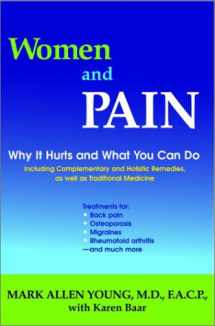
Women and Pain: Why It Hurts and What You Can Do--Including Complementary and Holistic Remedies, As Well as Traditional Medicine
Book details
Summary
Description
In Women and Pain, Dr. Mark Young shows readers how to finally end their chronic, agonizing pain. Most women -- and indeed, many health care professionals -- don't know that:
--Women often exhibit different symptoms than men for the same ailments; for instance, with coronary artery disease, where men typically feel chest pain but women more frequently report pain in the back, neck and jaw. Since most doctors are trained to look for and treat the typical male symptoms, many will misdiagnose a woman or tell her it's all in her mind -- when she is actually experiencing very serious symptoms.
--Women have both lower pain thresholds and less pain tolerance than do men -- i.e., they feel more pain.
--Certain classes of drugs work better to relieve women's pain than they do men's.
--Women may be at greater risk for pain-related disability -- in part, because of their reproductive cycles.
--Controversial new research reveals how anatomical differences between men and women may at least partially explain their distinct responses to pain.
Finally, here is an empowering and revolutionary book by a medical doctor that recognizes what many women have long known: Our pain is a uniquely female issue . . . and many of our physicians simply don't understand how to deal with it. Studies now demonstrate that women feel more pain, seek help more aggressively, and are more open to alternative treatments than men. At last, Dr. Mark Young offers women the practical and complementary solutions that other practitioners may have overlooked. Women and Pain specifically addresses a complex array of strictly female symptoms and concerns -- from childbirth and menstrual pain to fibromyalgia and osteoarthritis -- that set us apart from men.
Many women live with chronic, agonizing pain that affects every aspect of their lives. Traditional medicine can only offer drugs and surgery, but often neither is successful. Yet most women do not know of the many complementary and holistic treatments for pain that can provide great relief. Nor can they find out about alternative remedies from their doctors, who, when conventional remedies are exhausted, may dismiss pain as stress-related or "in your head." In addition, most traditional treatments are based on research that has only included men.
Not only does Dr. Young show that women respond differently to pain and require different treatments, he also provides very specific remedies, backed by scientific studies, for relieving hundreds of painful ailments. Women and Pain covers the hormonal connection to pain; bone and joint pain; muscle and nerve pain; headache; sports injuries; and chronic, unending pain. In addition to describing the traditional medicine cabinet, the author includes foods that heal; muscle strategies, such as Shiatsu and massage; herbal and botanical remedies; exercises to speed healing; mind-body therapies; and acupuncture. He even includes recipes, such as "migraine meals," for certain problems. You can use most of the remedies on your own, although you will need to consult with your doctor about others, such as traditional medicine and acupuncture.
This groundbreaking book will be welcome news to all the women who suffer from chronic pain, but who have had no lasting relief from doctors and traditional medical approaches.


We would LOVE it if you could help us and other readers by reviewing the book
Book review



